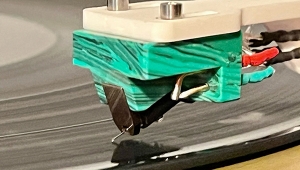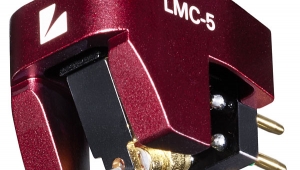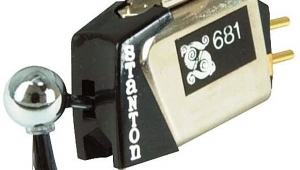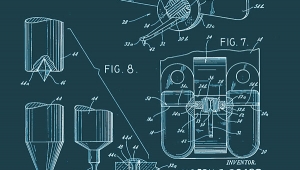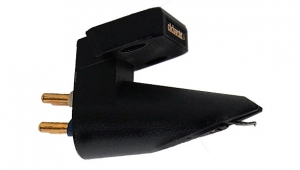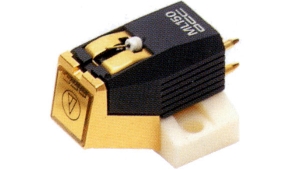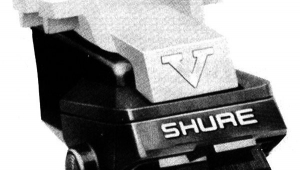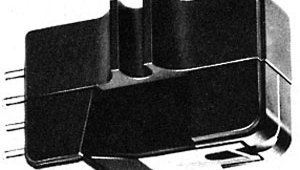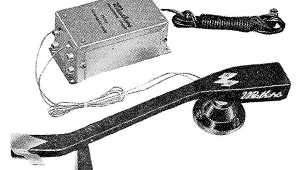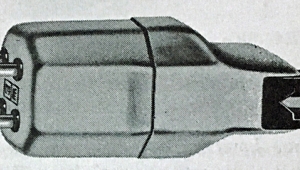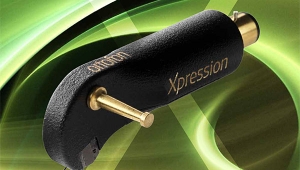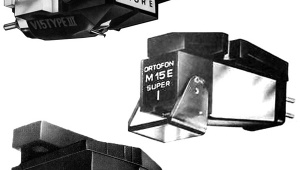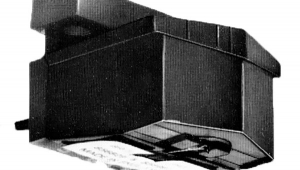| Columns Retired Columns & Blogs |
Ortofon MC Century phono cartridge
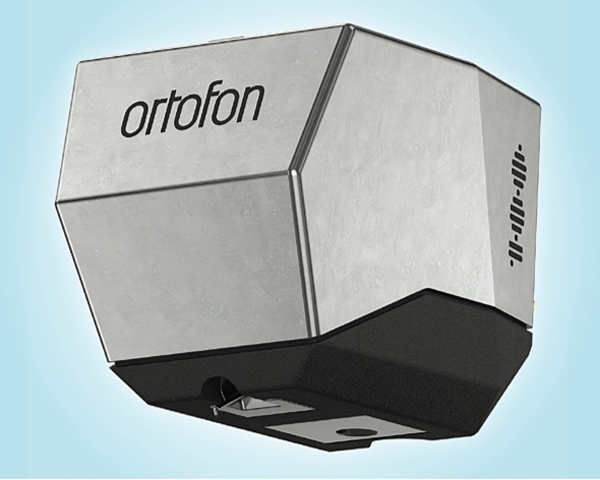
A few years ago, Leif Johannsen, Ortofon's chief officer of acoustics and technology, was tasked with designing new products to commemorate the company's 100th anniversary, in 2018 (footnote 1). Ten years ago, to celebrate Ortofon's 90th, he came up with the radical A90 moving-coil cartridge, which used Selective Laser Melt (SLM) technology to laser-weld together microparticles of stainless steel, layer by layer, to produce a 3D-printed metal body whose shape would have been impossible to machine. The process produces a cartridge body of greater than usual rigidity and density that dramatically reduces resonances. For Ortofon's 95th anniversary, Johannsen devised the A95. The A90 ($4200) and A95 ($6499) are two of my favorite cartridges from any manufacturer. Between those models, Johannsen designed the MC Anna ($8924), which was then Ortofon's most expensive MC cartridge, named after operatic soprano Anna Netrebko.
Footnote 1: Leif Johannsen discusses all of Ortofon's centenary products in a video I shot at High End 2018.
The MC Anna's curvaceous body is made not of stainless steel but of titanium. Unlike the A90's, the Anna's armature is nonmagnetic, which means it's lower in both mass and the amount of back-EMF it produces, with the result of wider dynamic range. However, omitting the ferrous material from the armature reduced the cartridge's already low output. Johannsen compensated with a new, more efficient neodymium and iron-cobalt generating system that produced more uniformly delivered magnetic field strength, which, according to Ortofon, allowed each coil to sense identical flux density, regardless of its position.
The A95, released a few years after the MC Anna, more closely resembled the A90 in appearance, but incorporated some of the Anna's innovations at a considerably lower price ($6499), including a body of SLM titanium and a nonmagnetic armature. The A95 retained the A90's nimble, uncolored sound, along with some of the Anna's richness and fullness. Overall, the A95's sound was more fully fleshed out than the A90's, which some (not I) had found a bit lean. I occasionally install and use the A90, maybe in part to be reminded of what was then a breakthrough design. I still enjoy listening to it.
Still, the MC Anna's sound was somewhat fat on the bottom, though not objectionably so. In my May 2013 column, I described it as "a slight but broad nudge in the lower mids and upper bass." Though the MC Anna was equally enjoyable with every kind of music, I found it most appropriate for acoustic music, not rock.
Like the MC Anna, the MC Century is big, and, at 15gm, just 1gm lighter. But its body is more angular, while avoiding, for obvious reasons, parallel surfaces. As with the Anna, the Century's body is of SLM titanium, parts of the magnet system are made of an iron-cobalt alloy, there's an armature-damping system claimed to provide "complete elimination of unwanted resonance," and the cantilever is fitted with a "nude" Ortofon Replicant 100 diamond stylus, which Ortofon claims is closest in shape to the cutting-head stylus used to create the groove in the first place, for maximal contact with the groove walls. In terms of parts, the biggest difference between the MC Anna and the MC Century is in their cantilever materials: boron for the Anna, diamond for the Century. (For other specifications, see sidebar.)
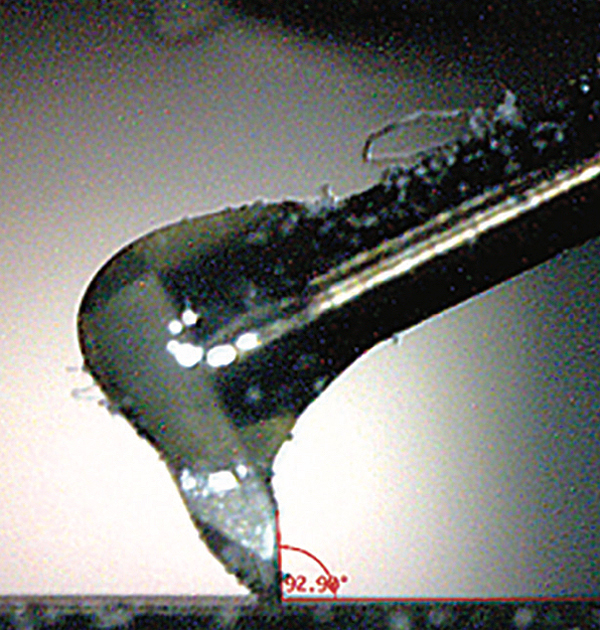
Viewed under magnification, the MC Century's stylus—seen here with SRA set to 92°›is cleanly bonded to its cantilever.
The Century's bottom protective cover is made of a proprietary thermo-plastic elastomer (TPE) with high damping properties. There's also a click-to-fit stylus guard. Only 100 MC Centurys will be produced, for $12,000 each.
Description and Setup
Unlike the MC Anna, the MC Century's stylus is not tucked under its body, which makes alignment easier. On the other hand, the stylus isn't fully exposed, as it is on the Goldfinger Statement ($16,000), which means it's comfortably protected from a costly "Oops!"—unless you're extremely unlucky or clumsy or both.
The MC Century is a perfect match for a high-mass, high-precision tonearm with gimbaled bearing, like the Swedish Analog Technologies arm I used. Setup was straightforward, and with the arm parallel to the record surface, the stylus rake angle (SRA) was 92.7°. Under dynamic conditions this would be even closer to 92°, but remember: The cutter-head SRAs measured for Jon M. Risch and Bruce R. Maier's groundbreaking article in the March 1981 issue of Audio magazine, "More Than One Vertical Tracking Angle," ranged from 91° to 94°—so 92° is a reasonable compromise. If you want to set it by ear for each record in your collection, starting at a measured 92°, please do!
I was able to confirm many of Ortofon's specifications for this hand-built, limited-edition cartridge, including the channel separation and channel balance, both at 1kHz, of a respective 25dB and 0.5dB. Using a microscope to view and photograph the MC Century's stylus allowed me to see the high-precision bond between the tip and the diamond cantilever. (My stockpile of dozens of such photos from various manufacturers shows a wide range of quality, including a few with big globs of glue that almost obscure the stylus while adding unwanted mass.) In short, everything visible and measurable in the MC Century is what you should expect for $12,000 or $8000 or even $5000. As for the sound . . .
Sound
There are "house sounds" among the best cartridge manufacturers, with variations depending on such factors as price and technology. The "less best" manufacturers produce wildly varying sonics among their different models. So the cartridges from Yoshio Matsudaira, for instance, whether sold under his brand My Sonic Labs or others—including Air-Tight, Haniwa, and TechDAS—share a few particular sonic qualities, although the sound of each is distinctive, depending on price, stylus, etc. The same is true of the cartridge lines of Lyra, Benz-Micro, and Dynavector (though I've not heard a Dynavector in a long time). While all of the cartridges in Ortofon's HiFi line—the Windfeld Ti, A90, A95, MC Anna, MC Century, etc.—sound more alike than different, there were definite differences between the MC Anna and the new MC Century.
I ran the MC Century into the Ypsilon VPS-100 Silver phono preamplifier using Ypsilon's MC-16 step-up transformer, and into the CH Precision P1 phono stage (through both the voltage- and current-amplification inputs). While there were differences, the basic contours of the MC Century's sound were consistent.
That sound was free of any mechanical artifacts, bright edges, or etch. Take the MC Anna's bottom end, and considerably tighten it up without damaging that cartridge's attractive low-end voluptuousness, to produce the kind of bottom-end depth and authority usually associated with tape. (I don't think I've ever before used the T-word in a cartridge review.) Splice all that to the A95's retrieval of detail and ability to carve aural images in three dimensions, and add the Windfeld Ti's luxuriously natural midband, and you have a general understanding of what this cartridge does. Were I able to measure the MC Century's frequency response, I'm sure it would be remarkably flat and smooth, minus the usual top-end peak.
Did you know that, in 1994, Classic Records produced a series of test pressings of 78rpm editions of RCA Living Stereo LP releases? Neither did I. An Australian friend snagged a few for me, including Fritz Reiner and the Chicago Symphony Orchestra performing Strauss Waltzes (LSC-2500), Prokofiev's Lieutenant Kijé (LSC-2150), and, with pianist Byron Janis, Liszt's Totentanz (LSC-2541). The MC Century moved through these high-speed and, of course, well-spread-out grooves with ease. The bottom end and dynamic slam on these 78s is insane, but even more impressive was the wide-open midband generosity and the sonic wholeness, as well as the stage width and depth.
While the MC Century delivered solidly three-dimensional images, it left none of them hanging unnaturally in space. Instead, it presented the best recordings "whole" without obscuring detail. Its resolution of low-level information—hall reverberation and instrumental decays—was as good as I've heard from any cartridge, and better than most, without spotlighting.
The Replicant 100 stylus profile is among the most radical, but when properly set up it will deliver resolution of fine detail without any mechanical additives. The shimmer of drummer Allan Mednard's cymbals on bassist Ben Allison's new Layers of the City (Sonic Camera SC-1701-1) was noticeably more resolved than through two other excellent and costly cartridges here for review, which smoothed them over to a sssshhhhhh. Yet the MC Century was also a real smoothie—it tracked vocal sibilants as well as any cartridge I've heard, and certainly better than did van den Hul's Colibri XGW Stradivarius Signature, reviewed in my August 2018 column.
The MC Century might be the cartridge for those who find even the SL version of Lyra's Atlas too analytical. I think the Atlas SL has somewhat greater midrange transparency in the sense of an "open window," but it doesn't match the MC Century's harmonic generosity, which is closer to that of the Etna SL. Then again, the Etna SL isn't as open and transparent, and it lacks the Atlas's and the MC Century's drama and dynamic authority.
Summing Up
Of all of the costly and magnificent-sounding cartridges I've reviewed, the MC Century gets out of the way better than any—and, like the Transfiguration Proteus D, does so without producing the boredom of some of the softies-but-goodies.
The MC Century is supposed to be Ortofon's finest cartridge to date. It is. I can't imagine how Leif Johannsen can ever top it, but I'm sure he'll try.
Footnote 1: Leif Johannsen discusses all of Ortofon's centenary products in a video I shot at High End 2018.
- Log in or register to post comments
